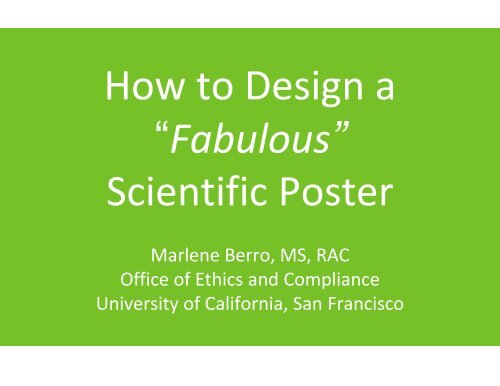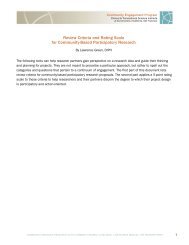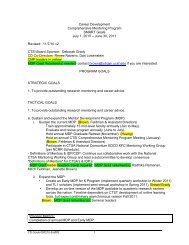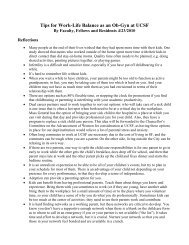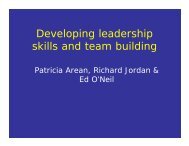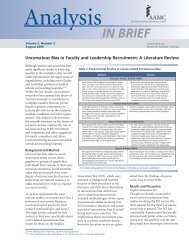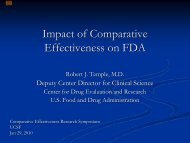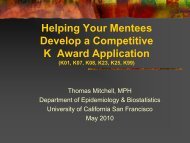Marlene Berro, MS, RAC Office of Ethics and ... - Accelerate
Marlene Berro, MS, RAC Office of Ethics and ... - Accelerate
Marlene Berro, MS, RAC Office of Ethics and ... - Accelerate
Create successful ePaper yourself
Turn your PDF publications into a flip-book with our unique Google optimized e-Paper software.
How to Design a<br />
“Fabulous”<br />
Scientific Poster<br />
<strong>Marlene</strong> <strong>Berro</strong>, <strong>MS</strong>, <strong>RAC</strong><br />
<strong>Office</strong> <strong>of</strong> <strong>Ethics</strong> <strong>and</strong> Compliance<br />
University <strong>of</strong> California, San Francisco
What is a Scientific Poster<br />
• A scientific poster is concise overview <strong>of</strong> your research project-<br />
42 x 42 for DDCF National Meeting<br />
• Title-try <strong>and</strong> keep it short if possible<br />
• Introduction-invitation to read your poster; can be in bullets or<br />
short paragraphs<br />
• Methods-description <strong>of</strong> methods used; can include graphics, flow<br />
charts etc.<br />
• Results-if using tables, please try <strong>and</strong> keep them short<br />
• Discussion <strong>of</strong> results-try to use bullets with as little punctuation as<br />
possible<br />
• References-can be in a much smaller font <strong>and</strong> optional<br />
• Acknowledgement <strong>of</strong> support-grant wording <strong>and</strong>/or thanking<br />
people
PregnantWomen sPercep ons<strong>and</strong><br />
Experiences<strong>of</strong>HIVS gmainRuralKenya<br />
Yve eP.Cuca<strong>and</strong>JanetM.Turan<br />
University<strong>of</strong>California,SanFrancisco<br />
Introduc on<br />
• 33millionpeoplearoundtheworldarelivingwithHIV/AIDS,22millionin<br />
sub‐SaharanAfrica.Inthisregion,womenmakeup60%<strong>of</strong>PLHA.<br />
• An retroviraltherapyhelpspeoplelivelonger<strong>and</strong>healthierlives,<strong>and</strong><br />
significantlyreducestherisk<strong>of</strong>mother‐to‐childtransmission.<br />
Sta s calAnalysis<br />
• Variableswereselectedforthemul variable<br />
modelbasedonsignificanceinthebivariate<br />
analysis(p≤.05),poten alconfounders,<br />
<strong>and</strong>factorsthatwereaprioriconsidered<br />
tobeimportant,basedontheliterature.<br />
Results(con nued)<br />
An cipatedS gma<br />
• Womenwithsignificantlygreateradjustedodds<strong>of</strong>an cipa ng<br />
s gmawere25+yearsold(AOR=1.35,p=.046),couldreadonlywith<br />
difficulty(AOR=1.43,p=.007),<strong>and</strong>hadhusb<strong>and</strong>swhohadother<br />
wives(AOR=1.42,p=.006).<br />
• However,HIV‐relateds gmaiss llaproblem.PLHAhaveexperienced<br />
emo onal,physical,<strong>and</strong>structuralabuse.S gmacanbeabarrierforHIV<br />
tes ng<strong>and</strong>treatment.<br />
• Womenmaybedispropor onatelyaffected<br />
bys gmabecause<strong>of</strong>theirsocialstatus.<br />
Womenwh<strong>of</strong>ears gmamaychosenot<br />
toaccessimportanthealthcareservices,<br />
<strong>and</strong>pregnantwomenmaynotaccess<br />
perinatalcare.<br />
Objec ve<br />
Toexaminesociodemographicpredictors<strong>of</strong>an cipated,perceived,<strong>and</strong><br />
experienceds gmaamongpregnantwomena endingantenatalcareclinics<br />
inruralKenya.<br />
<br />
Thisinforma oncanhelphealthcareworkersiden fywomenwhoaremost<br />
atrisk<strong>of</strong>experiencings gma,<strong>and</strong>providemoreappropriatecounseling<strong>and</strong><br />
services.Ul mately,thismayimprovetes ng<strong>and</strong>treatment,<strong>and</strong>thehealth<br />
<strong>of</strong>women<strong>and</strong>theirchildren.<br />
Methods<br />
• Thisisasecondaryanalysis<strong>of</strong>aprospec vecohortstudy,“ TheEffects<strong>of</strong><br />
HIV/AIDSS gmaonUse<strong>of</strong>ServicesbyPregnantWomeninKenya,” <br />
conductedinthecontext<strong>of</strong>theUCSF/KenyaMedicalResearchIns tute<br />
FamilyAIDSCare<strong>and</strong>Educa onServices(FACES)project.<br />
• 1,777womenwhodidnotknowtheirHIVstatuswereinterviewed.<br />
• WomenwhotestedHIV‐posi ve,<strong>and</strong>ar<strong>and</strong>omsample<strong>of</strong>thosewho<br />
testednega veorrefusedtes ng,wereselectedforfollow‐up:432hada<br />
postpartuminterview(157HIV+,168HIV‐,107statusunknown).<br />
• HIVKnowledgewasmeasuredby10ques ons(“ DoyouthinkahealthylookingpersoncanbeinfectedwithHIV,thediseasethatcausesAIDS?”<br />
“ CantheHIVvirusbetransmi edfrommothertochildduringdelivery?” )<br />
• An cipateds gma:thean cipa onthatonewillexperiences gmaifone<br />
testsHIV‐posi ve<strong>and</strong>one’ sHIV‐posi vestatusisdisclosedtoothers.<br />
• Perceiveds gma:thewoman’ snega vea tudes(“ PLHAshouldbe<br />
ashamed” ),<strong>and</strong>herpercep ons<strong>of</strong>discrimina onthattheyexperience<br />
(“ PLHAinthiscommunityfaceneglectfromtheirfamily” ).<br />
• Experienceds gma:howo envariouss gma zingeventshappenedto<br />
thewomaninthepastthreemonthsbecause<strong>of</strong>herHIV‐posi vestatus<br />
(eg.“ Someoneinsultedme,” “Ifeltcompletelyworthless” ).<br />
• Analysis<strong>of</strong>an cipated<strong>and</strong>perceived<br />
s gmaincludedall<strong>of</strong>thewomen<br />
interviewedatbaseline(n=1,777).<br />
Analysis<strong>of</strong>experienceds gmaincluded<br />
onlyHIV‐posi vewomeninterviewed<br />
atpostpartum(n=157).<br />
Results<br />
Characteris cs<strong>of</strong>StudyPar cipants(n=1,777)<br />
Age,years,mean±SD<br />
Level<strong>of</strong>educa oncompletedPrimary<br />
<br />
Secondary+<br />
Literacy Readeasily<br />
Readwithdifficulty<br />
Donotreadatall<br />
MaritalStatus Single(nevermarried)<br />
Married<br />
SeparatedorDivorced<br />
Widowed<br />
Husb<strong>and</strong>hasotherwives(yes)<br />
Work Housework<br />
Other<br />
Ownership<strong>of</strong>Householdgoods<br />
Electricity<br />
Radio<br />
Television<br />
L<strong>and</strong>linetelephone<br />
Mobilephone<br />
Refrigerator<br />
Meanpregnancies,includingcurrent<br />
Meanlivebirths<br />
An cipatedanys gma<br />
Frompartner<br />
Fromfamily<br />
Fromcommunity/others<br />
MeanCommunitys gmascore(range:0‐3)<br />
Nega veA tudes<br />
PerceivedDiscrimina on<br />
HIVKnowledge(meanpercentcorrect)<br />
HIVStatus HIV‐posi ve<br />
HIV‐nega ve<br />
RefusedHIVTes ng<br />
Tes ngServiceNotAvailable<br />
MissingResultinMedical<br />
Record<br />
23.6±5.4(range:18‐49)<br />
82.5%<br />
17.5%<br />
43%<br />
41%<br />
16%<br />
8.4%<br />
87.5%<br />
1.1%<br />
3.0%<br />
24.7%<br />
22.6%<br />
77.4%<br />
<br />
3.6%<br />
74.9%<br />
10.5%<br />
1.3%<br />
47.2%<br />
.96%<br />
3.2±2.0(range:1‐16)<br />
2.2±2.0(range:0‐15)<br />
28.4%<br />
35.3%<br />
35.0%<br />
59.1%<br />
.84±.38<br />
.78±.46<br />
.88±.43<br />
82.6%<br />
257(14.5%)<br />
1,204(67.8%)<br />
99(5.6%)<br />
203(11.4%)<br />
14(0.8%)<br />
• Thosewhohadloweradjustedoddshadmoreeduca on(AOR=.59,<br />
p=.006)<strong>and</strong>moreHIVknowledge(AOR=.92,p=.003;.58,p=.015).<br />
Nega veA tudes<br />
• Womenwhosehusb<strong>and</strong>shadotherwiveshadsignificantlyhigher<br />
adjustednega vea tudesscores(beta=.07;p=.018).<br />
• Thosewhohadlowerscoresworkedinsidethehome(beta=‐.07,p=.<br />
029),<strong>and</strong>hadmoreHIVknowledge(beta=‐.10,p=.003).<br />
PerceivedDiscrimina on<br />
• Women’ spercep ons<strong>of</strong>discrimina onagainstPLHAwere<br />
significantlyloweramongthoseworkedinsidethehome<strong>and</strong>those<br />
withbe erHIVknowledge.<br />
• Percep ons<strong>of</strong>discrimina onwerehigheramongthosewholivedin<br />
householdsthathadelectricity(beta=.23,p
Creating an effective poster<br />
requires time <strong>and</strong> planning<br />
What's my message?<br />
Everything you put on your poster relates to a carefully<br />
crafted message.<br />
• You must be able to state your main point(s) <strong>and</strong><br />
conclusion(s) clearly <strong>and</strong> succinctly.<br />
• All visuals <strong>and</strong> text should relate to those points<br />
<strong>and</strong> conclusions.
Your Title Here<br />
Authors name here 1 ,<br />
<br />
<br />
<br />
1 Affitliations here<br />
<br />
Introduc on<br />
• Lorem ipsum dolor sit amet, consectetur adipisicing elit, sed do eiusmod tempor<br />
incididunt ut labore et dolore magna aliqua. Ut enim ad minim veniam, quis<br />
nostrud exercitation ullamco laboris nisi ut aliquip ex ea commodo consequat. Duis<br />
aute irure dolor<br />
Sta s calAnalysis<br />
• We used multivariate analysis to study the numbers <strong>and</strong> types <strong>of</strong><br />
errors produced in relation to the subjects’ diagnoses.<br />
• Since attempts at three <strong>of</strong> the syntactic constructions were<br />
consistently difficult to elicit across the groups, we chose not to<br />
include these constructions in the final analysis.<br />
Results(con nued)<br />
• Lorem ipsum dolor sit amet, consectetur adipisicing<br />
elit, sed do eiusmod tempor incididunt ut labore et<br />
dolore magna aliqua. Ut enim ad minim veniam, quis<br />
Figure 2. VBM – Syntactic Accuracy<br />
Results<br />
• Lorem ipsum dolor sit amet, consectetur adipisicing elit, sed do<br />
eiusmod tempor incididunt ut labore et dolore magna aliqua. Ut<br />
enim ad minim veniam, quis<br />
• Across groupLorem ipsum dolor sit amet, consectetur adipisicing<br />
elit, sed do eiusmod tempor incididunt ut labore et dolore magna<br />
aliqua. Ut enim ad minim veniam, quis<br />
• Although they attempted a similar number <strong>of</strong> structures compared<br />
to other patient groups <strong>and</strong> controls, NFV patients performed worse<br />
(74.0%) than the other four groups; this difference was highly<br />
significant (F(4,41)=5.94, p= 0.0007).<br />
Table 3. Attempted Items <strong>and</strong> Correct Items by Patient Group<br />
SpecificAims<br />
• Lorem ipsum dolor sit amet, consectetur adipisicing elit, sed do eiusmod tempor<br />
incididunt ut labore et dolore magna aliqua. Ut enim ad minim veniam, quis<br />
• Lorem ipsum dolor sit amet, consectetur adipisicing elit, sed do eiusmod tempor<br />
incididunt ut labore et dolore magna aliqua. Ut enim ad minim veniam, quis<br />
Methods<br />
• Lorem ipsum dolor sit amet, consectetur adipisicing elit, sed do eiusmod tempor<br />
incididunt ut labore et dolore magna aliqua. Ut enim ad minim veniam, quis<br />
Table 2: Example <strong>of</strong> cut <strong>and</strong> paste table<br />
• Lorem ipsum dolor sit amet, consectetur adipisicing elit, sed do<br />
eiusmod tempor incididunt ut labore et dolore magna aliqua. Ut<br />
enim ad minim veniam, quis<br />
• Lorem ipsum dolor sit amet, consectetur adipisicing elit, sed do<br />
eiusmod tempor incididunt ut labore et dolore magna aliqua. Ut<br />
enim ad minim veniam, quis<br />
• Lorem ipsum dolor sit amet, consectetur adipisicing elit, sed do<br />
eiusmod tempor incididunt ut labore et dolore magna aliqua. Ut<br />
enim ad minim veniam, quis<br />
Figure 1. Types <strong>and</strong> Numbers <strong>of</strong> Errors by Patient Group<br />
Conclusions<br />
• Lorem ipsum dolor sit amet, consectetur adipisicing<br />
elit, sed do eiusmod tempor incididunt ut labore et<br />
dolore magna aliqua. Ut enim ad minim veniam, quis<br />
• The<br />
• Compared to controls<br />
• When considering all responses<br />
•<br />
Table 2: Example <strong>of</strong> table made in ppt<br />
Structure Scenario SampleResponses<br />
Loremipsum<br />
Loremipsum<br />
Loremipsum<br />
LoremipsumLoremipsumLorem Loremipsum<br />
ipsum<br />
LoremipsumLoremipsumLorem Loremipsum<br />
ipsum<br />
LoremipsumLoremipsumLorem Loremipsum<br />
ipsum<br />
Acknowledgments<br />
This project was supported by NIH/NCRR/OD UCSF-CTSI Grant Number TL1<br />
RR024129. Its contents are solely the responsibility <strong>of</strong> the authors <strong>and</strong> do not<br />
necessarily represent the <strong>of</strong>ficial views <strong>of</strong> the NIH.<br />
We thank all <strong>of</strong> the patients, caregivers <strong>and</strong> volunteers for their participation in our<br />
research.
Title Here: 60‐72 pt<br />
Authors Here: 38‐40 pt<br />
Institutions Here: 24‐26 pt<br />
Insert boxes <strong>of</strong> text, figures, tables in<br />
columns below:<br />
Use either heading color with black or<br />
white text<br />
Template size is 42 x 42<br />
Introduction<br />
• South Asians come from the Indian subcontinent, including India, Pakistan, Sri<br />
Lanka, Nepal, <strong>and</strong> Bangladesh<br />
• Compared to other ethnicities, South Asians have at least a two-fold increased risk<br />
<strong>of</strong> cardiovascular disease, myocardial infarction, type 2 diabetes, <strong>and</strong><br />
cardiovascular death<br />
Methods (continued)<br />
• South Asians come from the Indian subcontinent, including India, Pakistan, Sri<br />
Lanka, Nepal, <strong>and</strong> Bangladesh<br />
• Compared to other ethnicities, South Asians have at least a two-fold increased risk<br />
<strong>of</strong> cardiovascular disease, myocardial infarction, type 2 diabetes, <strong>and</strong><br />
cardiovascular death<br />
Results (continued)<br />
Graphs/tables/figures<br />
Specific Aims<br />
• South Asians come from the Indian subcontinent, including India, Pakistan, Sri<br />
Lanka, Nepal, <strong>and</strong> Bangladesh<br />
• Compared to other ethnicities, South Asians have at least a two-fold increased risk<br />
<strong>of</strong> cardiovascular disease, myocardial infarction, type 2 diabetes, <strong>and</strong><br />
cardiovascular death<br />
• , myocardial infarction, type 2 diabetes, <strong>and</strong> cardiovascular death<br />
Methods<br />
• South Asians come from the Indian subcontinent, including India, Pakistan, Sri<br />
Lanka, Nepal, <strong>and</strong> Bangladesh<br />
• Compared to other ethnicities, South Asians have at least a two-fold increased risk<br />
<strong>of</strong> cardiovascular disease, myocardial infarction, type 2 diabetes, <strong>and</strong><br />
cardiovascular death<br />
Statistical Analysis<br />
• Student’s t-test was used for comparison <strong>of</strong> continuous variables <strong>and</strong> chi-square<br />
test for proportions. Two-sided p-values were calculated for all test statistics<br />
<strong>and</strong> p < 0.05 was considered significant. Statistical analyses were<br />
performed using STATA Version 10 (College Station, TX).<br />
Results<br />
• South Asians come from the Indian subcontinent, including India, Pakistan, Sri<br />
Lanka, Nepal, <strong>and</strong> Bangladesh<br />
• Compared to other ethnicities, South Asians have at least a two-fold increased risk<br />
<strong>of</strong> cardiovascular disease, myocardial infarction, type 2 diabetes, <strong>and</strong><br />
cardiovascular death<br />
Conclusion<br />
• South Asians come from the Indian subcontinent, including India, Pakistan, Sri<br />
Lanka, Nepal, <strong>and</strong> Bangladesh<br />
• Compared to other ethnicities, South Asians have at least a two-fold increased<br />
risk <strong>of</strong> cardiovascular disease, myocardial infarction, type 2 diabetes, <strong>and</strong><br />
cardiovascular death<br />
Acknowledgments<br />
Please select one<br />
For researchers other than K scholars <strong>and</strong> PACCTR fellows<br />
This project was supported by NIH/NCRR UCSF-CTSI Grant Number UL1 RR024131. Its contents are<br />
solely the responsibility <strong>of</strong> the authors <strong>and</strong> do not necessarily represent the <strong>of</strong>ficial views <strong>of</strong> the NIH.<br />
For DDCF Fellows<br />
“This work was supported by a grant from the Doris Duke Charitable Foundation to to fund<br />
Clinical Research Fellow .” If you would like to use the Doris Duke Charitable<br />
Foundation logo as part <strong>of</strong> your poster, please send an email to ddcfcrf@aibs.org<br />
mailto:ddcfcrf@aibs.org<br />
For SOM Dean’s <strong>Office</strong><br />
Supported by a Dean's Research Fellowship from the UCSF School <strong>of</strong> Medicine<br />
For K scholars<br />
This publication [or project] was supported by NIH/NCRR/OD UCSF-CTSI Grant Number KL2<br />
RR024130. Its contents are solely the responsibility <strong>of</strong> the authors <strong>and</strong> do not necessarily represent the<br />
<strong>of</strong>ficial views <strong>of</strong> the NIH.<br />
For PACCTR fellows<br />
This publication [or project] was supported by NIH/NCRR/OD UCSF-CTSI Grant Number TL1<br />
RR024129. Its contents are solely the responsibility <strong>of</strong> the authors <strong>and</strong> do not necessarily represent the<br />
<strong>of</strong>ficial views <strong>of</strong> the NIH.<br />
Clinical <strong>and</strong> Translational Science Institute / CTSI<br />
Accelerating Research to Improve Health<br />
UC<br />
SF
Writing an effective abstract<br />
An effective abstract is your first opportunity to hone your message.<br />
An abstract is a succinct description <strong>of</strong> your work. It should:<br />
• Explain why your work is important - set the context <strong>and</strong><br />
pre-empt the question "So what?”<br />
• Describe the objective(s) <strong>of</strong> your work. What are you adding to<br />
current knowledge?<br />
• Briefly explain the methods. Unless the research is about<br />
methods, this should not be a major focus <strong>of</strong> your abstract (or<br />
your poster).<br />
• Succinctly state results, conclusions, <strong>and</strong> recommendations.<br />
This is what most people want to know. Do not say "We present<br />
the results <strong>of</strong> our study <strong>and</strong> recommendations for action" - tell<br />
them what you found <strong>and</strong> recommend!
Keep Graphics Clean<br />
<strong>and</strong> Simple<br />
Focus on your data<br />
No<br />
Yes
What Is the Optimal Interval <strong>of</strong> Mammography following Lumpectomy?<br />
VA Arasu 1 ; BN Joe 1 ; NM Lv<strong>of</strong>f 1 ; JWT Leung 1 ; RJ Brenner 1 ; C Flowers 2 ; B Chang 1 ; EA Sickles 1<br />
1<br />
Department <strong>of</strong> Radiology <strong>and</strong> Biomedical Imaging, Division <strong>of</strong> Women’s Imaging, 2 Department <strong>of</strong> Women’s Health,<br />
University <strong>of</strong> California, San Francisco USA<br />
Introduction<br />
Lumpectomy is st<strong>and</strong>ard treatment for early breast cancer<br />
• Conserves breast through local excision <strong>of</strong> cancer<br />
• Used in stage 0 – stage 2 breast cancer<br />
• Equivalent efficacy to mastectomy<br />
Patients have a high risk for recurrence<br />
• Baseline risk <strong>of</strong> breast cancer in healthy women: 0.5% per<br />
year<br />
• Recurrence risk after lumpectomy: 1-2% per year<br />
• Patients with recurrence have 3x mortality rate<br />
• Higher stage recurrence predicts worse prognosis<br />
• Stage 2 recurrence has 50% worse prognosis than stage<br />
1<br />
Optimal interval for surveillance is unknown<br />
• Clinical exam <strong>and</strong> mammography best methods to detect<br />
recurrence<br />
• No evidence for interval using mammography<br />
• Interval is variable in clinical practice<br />
- Cancer organizations: Every 12 months<br />
• UCSF: Every 6 months for 5 years<br />
Research Question<br />
• In lumpectomy patients at UCSF, do mammograms at 6-<br />
month intervals detect cancers earlier?<br />
Methods<br />
Patients <strong>and</strong> Data Collection<br />
• Retrospective review from 1997 – 2008 <strong>of</strong> mammograms<br />
following lumpectomy<br />
• Collected from UCSF Mammography Database<br />
• Predictor: 6-month or 12-month interval is time between the<br />
last negative mammogram <strong>and</strong> positive mammogram that<br />
detects recurrence (Fig. 1)<br />
• Study Endpoint: Cancer recurrence using TNM staging<br />
criteria<br />
Methods (continued)<br />
Statistical Analysis<br />
• Fisher’s exact test comparing the proportions in stage 0+1<br />
vs. stage 2+3+4<br />
• A threshold between stage 1 <strong>and</strong> 2 chosen a priori because it<br />
represents the largest drop in prognosis<br />
Results<br />
Patient Characteristics<br />
• 2,329 women, 10,750 exams identified<br />
• 8,421 mammogram exams included<br />
• 2,545 exams excluded<br />
• No significant baseline differences in risk <strong>of</strong> breast cancer<br />
by age, family history<br />
Cancer Recurrence<br />
• 109 recurrences over 5 years (Table 1)<br />
• No recurrences beyond stage 2<br />
• 1.3% vs. 1.2% recurrences/yr in 6 vs. 12-month<br />
Results (continued)<br />
Conclusion<br />
• Mammogram exams at 6-month intervals detects<br />
recurrence significantly earlier<br />
• Number needed to screen (NNTS) = 81 to prevent<br />
stage 0/1 stage 2<br />
• Recurrences detected <strong>and</strong> treated at earlier stage may<br />
lead to better overall survival<br />
• Ffirst evidence that 6-month exam intervals following<br />
lumpectomy is optimal<br />
• May change guidelines by cancer organizations<br />
• Establishing clinical efficacy will require an RCT<br />
Acknowledgments<br />
This research was supported by an NIH TL1 RR024129<br />
<strong>and</strong> Doris Duke Charitable Foundation Award #2007084.<br />
Many Thanks to Joel Palefsky, Peter Chin-Hong. Cecily Hunter<br />
<strong>and</strong> <strong>Marlene</strong> <strong>Berro</strong><br />
Clinical <strong>and</strong> Translational Science Institute / CTSI<br />
Bringing better health to more people more quickly!<br />
UCSF
Define your message<br />
All visuals <strong>and</strong> text should relate to a succinctly stated<br />
message.<br />
Know your message! What is the one thing you want your<br />
audience to learn?<br />
Be bold & be explicit.<br />
• If you have an interesting result, state it explicitly in the title<br />
The Effect <strong>of</strong> X on Y or Substance X Induces Y-cells<br />
• Make the strongest statements your data will support<br />
Why s<strong>of</strong>t-peddle exciting findings?
Know your audience<br />
Make your message accessible to a diverse audience.<br />
People in your field <strong>of</strong> specialization<br />
• No special efforts are required to attract them.<br />
People in fields closely related to yours are worth capturing,<br />
because they can have interesting insights <strong>and</strong> perspectives<br />
about your work.<br />
People in unrelated fields can be attracted by an accessible<br />
message, <strong>and</strong> provide valuable insights <strong>and</strong> links to distant<br />
fields.
Headings<br />
Should include the title, section titles, <strong>and</strong> figure captions -<br />
• Summarize<br />
Use headings as opportunities to summarize your work in<br />
large letters.<br />
• Organize<br />
Good headings are part <strong>of</strong> the visual grammar that helps<br />
move readers through your poster.<br />
• Be Hierarchical<br />
The more important the point, the larger the type.<br />
• Be Bold<br />
Make the strongest statements your research allows.
Creating your poster<br />
1. Planning: Takes time<br />
2. Focus: Keep it simple<br />
3. Layout: Guide your readers<br />
4. Headings: Orientation<br />
5. Graphics: Simple <strong>and</strong> clean<br />
6. Text: Make it large<br />
7. Colors: Don’t overdo<br />
8. Editing: Allow enough time
Planning your poster<br />
Suggested schedule-Below are some ideas for establishing<br />
milestones. This schedule assumes that you're doing other<br />
things during the week. It also allows time for you to get<br />
feedback from collaborators <strong>and</strong> peers.<br />
When<br />
What<br />
0 Present poster<br />
-1 week Final print<br />
-1 week Make changes suggested by peers<br />
-1 week Distribute draft for peer review (round 2)<br />
-2 weeks Make changes suggested by peers<br />
-2 weeks Distribute draft for peer review (round 1)<br />
-3 weeks Edit your draft ruthlessly<br />
-3 weeks Create first draft <strong>of</strong> poster<br />
-4 weeks Plan out poster on scratch paper<br />
-4 weeks Define message <strong>and</strong> write an abstract (if you haven't already done so)
Poster Templates<br />
Poster resources <strong>and</strong> templates can be found at:<br />
the CTSI website:<br />
http://ctsi.ucsf.edu/about-us/ctsi-identity<br />
<strong>and</strong><br />
The UCSF library website:<br />
http://www.library.ucsf.edu/help/postersupport<br />
If there is a specific template that you would like to use, please contact <strong>Marlene</strong> at:<br />
marlene.berro@ucsf.edu
Word Counts<br />
• Approximate word counts should be as follows<br />
depending on your graphics.<br />
• Title - not too long-convey the "issue,”<br />
• Introduction (max 150 words)-Bullets or short<br />
paragraphs<br />
• Methods (max 150 words)-Describe the steps used to<br />
answer your scientific question
Word Counts (continued)<br />
• Aims - 50 words-Do not write an abstract<br />
• Data Analysis - 60<br />
• Results - 250 (not counting figure legends)<br />
1. First, mention whether experiment worked<br />
2. Briefly describe qualitative <strong>and</strong> descriptive results<br />
3. Refer to supporting charts or images<br />
4. Opt for figures whenever possible<br />
• Conclusion – 125 (can be bullets or short paragraphs)<br />
•Acknowledgment – can be found at:<br />
http://accelerate.ucsf.edu/cite
Acknowledgments<br />
For researchers other than K<br />
scholars <strong>and</strong> CTR fellows<br />
For DDCF<br />
Fellows<br />
For SOM Dean’s<br />
<strong>Office</strong><br />
For K scholars<br />
For CTR Fellowship Awardees<br />
This publication [or project] was<br />
supported by the National Center for<br />
Research Resources <strong>and</strong> the<br />
National Center for Advancing<br />
Translational Sciences, National<br />
Institutes <strong>of</strong> Health, through UCSF‐<br />
CTSI Grant Number UL1 RR024131.<br />
Its contents are solely the<br />
responsibility <strong>of</strong> the authors <strong>and</strong> do<br />
not necessarily represent the <strong>of</strong>ficial<br />
views <strong>of</strong> the NIH.<br />
“This work was<br />
supported by a<br />
grant from the<br />
Doris Duke<br />
Charitable<br />
Foundation to<br />
to<br />
fund Clinical<br />
Research Fellow<br />
<br />
Supported by a<br />
Dean's Research<br />
Fellowship from<br />
the UCSF School <strong>of</strong><br />
Medicine<br />
"This publication [or<br />
project] was supported by<br />
the National Center for<br />
Research Resources, the<br />
National Center for<br />
Advancing Translational<br />
Sciences, <strong>and</strong> the <strong>Office</strong> <strong>of</strong><br />
the Director, National<br />
Institutes <strong>of</strong> Health,<br />
through UCSF‐CTSI Grant<br />
Number KL2 RR024130. Its<br />
contents are solely the<br />
responsibility <strong>of</strong> the<br />
authors <strong>and</strong> do not<br />
necessarily represent the<br />
<strong>of</strong>ficial views <strong>of</strong> the NIH."<br />
This publication [or project] was<br />
supported by the National Center<br />
for Research Resources, the<br />
National Center for Advancing<br />
Translational Sciences, <strong>and</strong> the<br />
<strong>Office</strong> <strong>of</strong> the Director, National<br />
Institutes <strong>of</strong> Health, through<br />
UCSF‐CTSI Grant Number TL1<br />
RR024129. Its contents are solely<br />
the responsibility <strong>of</strong> the authors<br />
<strong>and</strong> do not necessarily represent<br />
the <strong>of</strong>ficial views <strong>of</strong> the NIH."<br />
http://accelerate.ucsf.edu/cite
ItComesDowntoMoney:WhyWomenDecideNottoUndergoFer lityPreserva on<br />
<br />
ErinEbbelNiemasikMD 1 ,Sai‐wingChan 2 ,JosephLetourneauMD 3 , Chia‐ningKao<strong>MS</strong> 2 ,AudraKatzRN 2 ,JeffBelkoraPhD 4 ,MitchellRosenMD 2<br />
1<br />
NYPWeillCornellDepartment<strong>of</strong>Obstetric<strong>and</strong>Gynecology, 2 University<strong>of</strong>CaliforniaSanFranciscoDepartment<strong>of</strong>Obstetrics,Gynecology<strong>and</strong>Reproduc veSciences, 3 UNCDepartment<strong>of</strong>Obstetrics<strong>and</strong>Gynecology,<br />
4<br />
University<strong>of</strong>CaliforniaSanFranciscoDepartment<strong>of</strong>Surgery<strong>and</strong>HealthPolicyStudies<br />
Abstract<br />
Introduc on<br />
Results<br />
Conclusions<br />
Introduc on<br />
Accordingto2012SEERsta s cs,approximately120,000<br />
reproduc ve‐agedwomendevelopinvasivecancerevery<br />
yearintheUnitedStates. 1 Withimprovingsurvivalrates<br />
<strong>and</strong>increasingawareness<strong>of</strong>pa ents’reproduc vedesires<br />
a ercancertherapy 2‐3 ,morewomenmayconsider<br />
undergoingfer litypreserva on(FP)priortocancer<br />
treatment.Despitena onalrecommenda ons 4‐5 thereare<br />
mul plebarriersforwomentoundergoFP,includingbeing<br />
referred<strong>and</strong>seenbyafer lityspecialist 4‐6 .Itises mated<br />
thatonly2‐5% 3 <strong>of</strong>womenreceivereproduc vecounseling<br />
fromafer lityspecialistbeforeundergoingcancertherapy.<br />
Ofwomenwhodogetcounseled,ac ontoundergoFP<br />
mays llbelow 7 .Wesoughttodeterminewhatbarriers<br />
preventwomenfromundergoingFPa eraconsulta on<br />
withafer lityspecialist.<br />
<br />
Methods<br />
FromJanuary2011topresent,reproduc veagedwomen<br />
withcancerwhopresentedtoareproduc vehealthclinic<br />
forFPcounselingwereconsentedtopar cipateina<br />
prospec vestudy.Pa entscompletesurveysat4 me<br />
points:before<strong>and</strong>a eranewpa entconsulta on,atthe<br />
metheymakeadecisionaboutFP<strong>and</strong>6‐8monthslater.<br />
Possiblereasonsincluded:riskst<strong>of</strong>er lityfromcancer<br />
therapy,partnerstatus,cost,lack<strong>of</strong>insurancecoverage,<br />
age,delay<strong>of</strong>cancertreatment,<strong>and</strong>futurepregnancy's<br />
effectonlongtermprognosis.<br />
<br />
Results<br />
Todate,132womenhavebeenrecruited(89%accrual<br />
rate).Inourstudy53.8%<strong>of</strong>womendidnotundergoFP.Of<br />
thosewhocompletedthesurveyat mepoint3,wefound<br />
that93.75%(30/32)<strong>of</strong>womeniden fiedcost(p=0.005)<br />
<strong>and</strong>lack<strong>of</strong>insurancecoverage(p=0.005)asreasonsfornot<br />
undergoingFP.Pregnancy'seffectonlongtermprognosis<br />
trendedtowardssignificance(p=0.085).Otherconcerns<br />
suchas:riskst<strong>of</strong>er lityfromcancertherapy(p=0.529),<br />
partnerstatus(p=0.315),age(p=0.552),ordelayingthe<br />
start<strong>of</strong>cancertherapy(p=0.552),werenotfoundtobe<br />
significant.<br />
<br />
Discussion<br />
Thisstudysuggeststhata eraconsulta onwithafer lity<br />
specialist,money<strong>and</strong>lack<strong>of</strong>insurancecoveragearethe<br />
twomostsignificantbarrierstoundergoingFP.Increased<br />
financialsupportservices<strong>and</strong>insurancecoveragefor<br />
womenwithmedicallyinducedinfer litymaysignificantly<br />
improveaccesstoadvancedreproduc vetechnologies.<br />
Improvementsinearlyscreening<strong>and</strong>therapeu ctechniqueshaveledto<br />
improvedcancersurvival.Thishasencouragedtheoncologycommunity<br />
toplacegreateremphasisonreproduc vehealthasanimportant<br />
survivorshipissue.<br />
Withincreasingknowledge<strong>of</strong>howlocal<strong>and</strong>systemiccancertherapies<br />
canleadtoacuteovarianfailure,infer lity<strong>and</strong>prematuremenopause,<br />
morewomenareconsul ngreproduc vespecialiststodiscusspreserving<br />
theirfer litypriortotreatment. 8 <br />
Previousstudieshaveshownthatconcerns<strong>of</strong>infer lity<strong>and</strong>premature<br />
menopausearesome<strong>of</strong>themostimportantsurvivorshipissuesforyoung<br />
women 2‐4 ,withupto29%<strong>of</strong>womenmakingfuturelife‐savingtreatment<br />
decisionsbasedonfear<strong>of</strong>infer lityorprematuremenopause 2 .<br />
Mul plebarriersexistforwomentobeseenbyafer lityspecialist 4‐7 ,yet<br />
studieshaveshownthatfewwomenmayundergoFPevena er<br />
counseling 7 .<br />
<br />
SpecificAims<br />
<br />
<br />
Wesoughttodeterminewhatbarrierspreventwomen<br />
fromundergoingFPa <br />
eraconsulta onwithareproduc ve<br />
specialist.<br />
Methods<br />
• Subjects:Womenrecentlydiagnosedwithcancerwho<br />
presentedforFPconsulta onfromJanuary2011to<br />
present,age18‐45yearsold<br />
• Pa entscompletesurveysat4 mepoints:before<strong>and</strong><br />
a eranewpa entconsulta on,atthe metheymakea<br />
decisionaboutFP<strong>and</strong>6‐8monthslater<br />
• BarrierstoundergoingFP:riskst<strong>of</strong>er lityfromcancer<br />
therapy,partnerstatus,cost,lack<strong>of</strong>insurancecoverage,<br />
age,delay<strong>of</strong>cancertreatment,<strong>and</strong>futurepregnancy's<br />
effectonlongtermprognosis<br />
• Chi‐squaretes ngwasusedinSAStoanalyzeresults<br />
• Con nuedac veenrollmentatall4 mepoints<br />
Todate132womenhavebeenrecruited(89%rate)<strong>and</strong>32<br />
womenhavecompletedsurveysthrough mepoint4.<br />
<br />
• Averageage33.4yearsold(range18‐45)<br />
• 77.3%desiredfuturefer lity<br />
• 84.5%werenulliparous<br />
• 47.7%underwentfer litypreserva on<br />
• 93.75%(30/32)womeniden fiedcost(p=0.005)<strong>and</strong><br />
lack<strong>of</strong>insurancecoverage(p=0.005)asareasonfornot<br />
undergoingFP.<br />
• Comparedtowomenwhomake$30k<br />
are8.2 mesmorelikelytoundergoFP(p=0.033)<br />
<br />
Table1:Pa entPopula on<br />
<br />
Demographic<br />
Age<br />
Increased phosphorylation <strong>of</strong> the MAPK/ERK pathway is<br />
associated with social impairment in BTBR mice<br />
Alireza Faridar, Dorothy M. Jones-Davis, Eric Rider <strong>and</strong> Elliott H. Sherr<br />
BACKGROUND<br />
Department <strong>of</strong> Neurology, University <strong>of</strong> California, San Francisco, CA<br />
RESULTS<br />
CTSI<br />
• Advances in autism genetic <strong>and</strong> in the study <strong>of</strong> animal<br />
models are providing evidences to suggest that<br />
MAPK/ERK (extracellular-signal-regulated kinase)<br />
pathway is altered in autism.<br />
Fig 1: Increased activity levels <strong>of</strong> MAPK/ERK in BTBR mice<br />
*<br />
*<br />
Fig 3: Phosphorylated MAPK/ERK<br />
levels correlate across<br />
brain <strong>and</strong> spleen<br />
• Dysregulated MAPK/ERK signaling pathway has been<br />
found in the brains <strong>of</strong> adult BTBR T+tf/J mice 1 , a strain<br />
exhibiting behaviors with face validity to autism 2 .<br />
OBJECTIVE<br />
Ras/Actin<br />
P-Erk/Actin<br />
BTBR B6 BTBR B6 BTBR B6<br />
Erk/Actin<br />
lymphocytes<br />
P-Mek/Actin BTBR & B6<br />
R 2 = 0.772<br />
p= 0.004<br />
lymphocytes<br />
Mek/Actin<br />
R 2 = 0.8756<br />
p= 0.0006<br />
To evaluate whether dysregulation <strong>of</strong> the ERK signaling<br />
pathway directly correlates with autism-relevant traits in<br />
autistic mice model<br />
A. Increased RAS & Phospho-ERK levels in the brains <strong>of</strong> newborn BTBR vs. B6 (p= 0.04 , p= 0.001,<br />
respectively), using western blot analysis. No significant change in total ERK levels was seen (p=0.8).<br />
*<br />
Brain<br />
Erk/Actin<br />
Brain<br />
METHODS<br />
1. We intercrossed BTBR <strong>and</strong> C57BL/6J mice <strong>and</strong><br />
assessed social behaviors in 400 F2 <strong>of</strong>fspring.<br />
2. The expression levels <strong>and</strong> state <strong>of</strong> phosphorylation<br />
<strong>of</strong> ERK <strong>and</strong> related kinases were evaluated in the<br />
prefrontal cortex <strong>of</strong> F2 mice that lie on the two<br />
extremes <strong>of</strong> the social behavior spectrum.<br />
BTBR<br />
x<br />
C57BL/6<br />
F1<br />
x<br />
F1<br />
F2 (n = 410)<br />
Ras/Actin<br />
*<br />
B. Increased RAS & Phospho-ERK levels in the brain <strong>of</strong> adult BTBR vs. B6 (P=0.002 & p=0.02, respectively),<br />
using western blot analysis. No significant change in total ERK levels was observed (p=0.16).<br />
Fig 2: Association between activity levels <strong>of</strong> MAPK/ERK<br />
<strong>and</strong> social behaviors<br />
P-Mek/Actin<br />
BTBR B6 BTBR B6 BTBR B6<br />
Impaired Normal<br />
*<br />
P-Erk/Actin<br />
Mek/Actin<br />
Erk/Actin<br />
Impaired Normal<br />
lymphocytes<br />
Brain<br />
R 2 = 0.5518<br />
p = 0.03<br />
• Significant association <strong>of</strong> P-MEK, MEK <strong>and</strong> ERK levels between<br />
brain <strong>and</strong> splenic lymphocytes <strong>of</strong> BTBR <strong>and</strong> C57BL/6 (p=0.004,<br />
p=0.0006, p=0.04)<br />
CONCLUSIONS<br />
• Levels <strong>of</strong> phospho-ERK were significantly increased in the brain <strong>of</strong><br />
newborn <strong>and</strong> adult BTBR vs. C57BL/6J (B6) mice.<br />
• We observed a significant correlation between juvenile social<br />
behavior impairment <strong>and</strong> activity levels <strong>of</strong> MAPK/ERK signaling<br />
pathway.<br />
• It is possible that phophorylation levels <strong>of</strong> MAPK/ERK kinases in<br />
peripheral blood lymphocytes may serve as a biomarker in clinical<br />
studies in autism<br />
Assessing brain anatomy & social behaviors<br />
P-Erk/Actin<br />
*<br />
Erk/Actin<br />
References<br />
1. Zou H, Yu Y, Sheikh AM, Malik M, Yang K, Wen G, Chadman KK, Brown WT, Li X.Association <strong>of</strong> upregulated Ras/Raf/ERK1/2 signaling<br />
with autism. Genes BrainBehav. 2011 Jul;10(5):615-24. doi: 10.1111/j.1601-183X.2011.00702.x.<br />
2. McFarlane HG, Kusek GK, Yang M, Phoenix JL, Bolivar VJ, Crawley JN.Autism-like behavioral phenotypes in BTBR T+tf/J mice. Genes<br />
Brain Behav. 2008Mar;7(2):152-63. Epub 2007 Jun 7. Erratum in: Genes Brain Behav. 2008Mar;7(2):163.<br />
Extracting proteins from prefrontal cortex<br />
Evaluating ERK pathway by western blot analysis<br />
Impaired Normal<br />
Impaired Normal<br />
• Significant correlation between phosphorylation levels <strong>of</strong> MEK/ERK <strong>and</strong> juvenile approach front behavior<br />
(p=0.008, p=0.03, respectively), when comparing mice that represent the extremes <strong>of</strong> behavior (normal &<br />
impaired). No difference in total RAS, MEK <strong>and</strong> ERK levels were observed.<br />
• We also tested p-MEK <strong>and</strong> p-ERK levels in other social measures (Juvenile push crawl, Juvenile nose to nose,<br />
Juvenile follow, Self grooming, Novel mouse sniff, Total juvenile interaction), but did not find a statistically<br />
significant difference.<br />
Acknowledgments<br />
This publication made possible by Grant Number UL1 RR024131 from the<br />
National Center for Research Resources (NCRR), a component <strong>of</strong> the National<br />
Institutes <strong>of</strong> Health (NIH), <strong>and</strong> NIH Roadmap for Medical Research. Its contents<br />
are solely the responsibility <strong>of</strong> the authors <strong>and</strong> do not necessarily represent the<br />
<strong>of</strong>ficial view <strong>of</strong> NCRR or NIH. Information on NCRR available at<br />
http://www.ncrr.nih.gov/. Information on Re-engineering the Clinical Research<br />
Enterprise can be obtained from<br />
http://nihroadmap.nih.gov/clinicalresearch/overview-translational.asp
Edit! Edit! Edit!<br />
• Edit all text to simplify verbiage, to reduce sentence<br />
complexity, <strong>and</strong> to delete details.<br />
• If it's not relevant to your message, remove it!<br />
• Have colleagues comment on drafts.<br />
• Print a small version <strong>and</strong> circulate for comment, or hang<br />
a full-size draft with pens <strong>and</strong> invite them to critique.<br />
• Are your objective <strong>and</strong> main message obvious?<br />
• Will readers be able to contact you?
Help with Your Poster<br />
• Prepare your text, graphs, tables, <strong>and</strong> figures as<br />
instructed<br />
• Assemble poster<br />
• If needed, call to set up a time to review materials<br />
• Email PDF <strong>of</strong> your poster to colleagues <strong>and</strong> friends for<br />
edits<br />
• I can assist with final pro<strong>of</strong> <strong>and</strong> editing.<br />
• I will send PDF to Mark Ayres at CTSI to print<br />
• You will pick up poster at Parnassus Campus<br />
Contact: <strong>Marlene</strong>.berro@ucsf.edu


